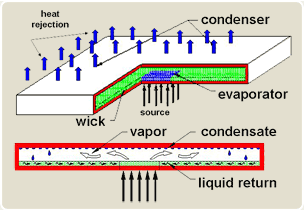Rensselaer Researchers Develop Heat Spreader for Epileptic Seizure Treatment Device

Rensselaer Polytechnic Institute researchers are developing a tiny, highly efficient heat spreader to be used in a new device to be implanted in the brain of patients who suffer from severe epileptic seizures. The implant device is designed to detect and arrest epileptic seizures as they begin by cooling a small region of the brain, thereby effectively blocking the erratic electrical activity.
G. P. “Bud” Peterson, provost and professor of mechanical, aerospace, and nuclear engineering at Rensselaer, and his team are collaborating with researchers at Washington University School of Medicine in St. Louis to design, model, test, and develop the implant device. The research and the potential of the device are featured in the July 16 issue of New Scientist.
The heat spreader being developed at Rensselaer utilizes a phase-change heat process, the same mechanism that the human body uses to cool itself, to transfer and distribute heat in the brain. The fundamental principal behind the operation of the heat spreader is evaporation and condensation, similar to perspiration. Using a pure substance, saturated conditions are created inside the heat pipe, resulting in evaporation in the heated regions. Heat entering the pipe turns the liquid water to vapor, which is forced along the pipe by high pressure where it is condensed in the cooler regions. The dissipated heat is then pushed out of the heat pipe, and the wicking structure pumps the liquid back to the evaporator.
“The heat spreader we created for this implant device acts as a very efficient thermal conductor, spreading and releasing the heat without minimal temperature increase, thereby preventing any potential tissue damage to the brain,” said Peterson. “The brain can tolerate temperature reductions on the order of 18 to 20°C without sustaining permanent damage. However, the brain cannot tolerate temperature increases over 0.5°C. This requires that the heat both absorbed and generated by the device be spread across a much larger surface area.”
Implanted on the neocortex of the brain, close to where erratic electrical activity is causing the epileptic seizure, the implant device is designed to detect the unusual level of electrical activity that accompanies these types of seizures. The implant device then is activated to cool a small area of the brain from approximately 38°C (100°F) to 20°C (68°F) to render that part of the brain temporarily non-functional and seizure-free, according to researchers.
The implant device works as a very small “thermoelectric refrigerator,” approximately 0.25 inches on a side, consisting of many tiny metal semiconductor junctions connected between two ceramic electrodes to create an electronic circuit. The result is an implantable device in which one side is cooled and other is heated as electrical current moves through it. The heat spreader being developed by Peterson and his team, allows the heat generated and absorbed by the implant device to be effectively released without a significant increase in temperature.
The implant device has been successfully tested on rats and has been approved by the National Institutes of Health (NIH) for testing in primates. Researchers expect the device will provide a new methodology for the treatment of epileptic seizures in humans.
Peterson has conducted research on heat pipes and related two-phase heat transfer devices for 25 years, holds eight patents, and is the author or co-author of more than 145 peer-reviewed journal articles in fields as diverse as electronics and spacecraft thermal control, energy recovery systems, biomedical applications, and the cooling of valve stems in internal combustion engines.
Source: Rensselaer Polytechnic Institute















